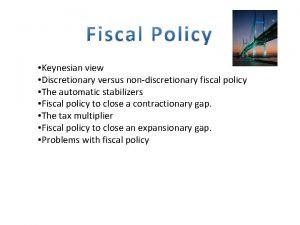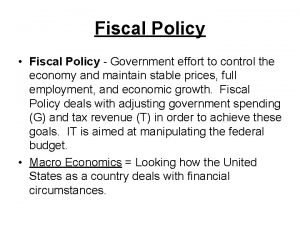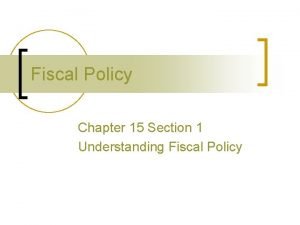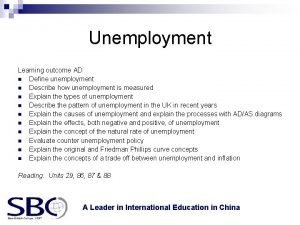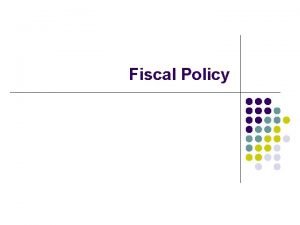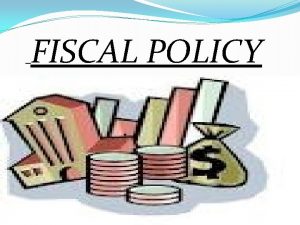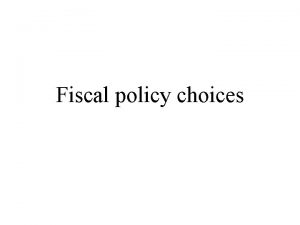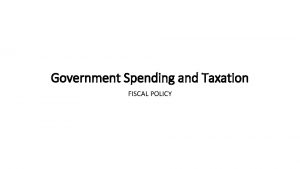PART FIVE Macroeconomic Measurement Models and Fiscal Policy





































- Slides: 37

PART FIVE Macroeconomic Measurement, Models, and Fiscal Policy

Chapter 12: Introduction to GDP, Growth, and Instability

Gross Domestic Product Gross domestic product (GDP) is the total market value of all final goods and services produced annually within the U. S. , whether by U. S. or foreign-supplied resources. l GDP is determined by the Bureau of Economic Analysis (BEA), an agency of the Commerce Department, and is the primary measure of the economy’s performance. Mc. Graw-Hill/Irwin Copyright 2007 by The Mc. Graw-Hill Companies, Inc. All rights reserved.

Gross Domestic Product l GDP is a monetary measure. l l It compares the relative value of goods and services produced in different year. To avoid counting components that are bought and sold multiple times, GDP includes on the market value of final goods and ignores intermediate goods altogether. Mc. Graw-Hill/Irwin Copyright 2007 by The Mc. Graw-Hill Companies, Inc. All rights reserved.

Gross Domestic Product l Secondhand goods are also excluded from GDP since they do not contribute to current production. l These goods were previously counted in the year they were produced. Mc. Graw-Hill/Irwin Copyright 2007 by The Mc. Graw-Hill Companies, Inc. All rights reserved.

Measuring GDP l The four categories of expenditures that provide a measure of the market value of total output in a particular year include: l l Personal consumption expenditure (C) Gross Private Domestic Investment (Ig) Government Purchases (G) Net Exports (Xn) Mc. Graw-Hill/Irwin Copyright 2007 by The Mc. Graw-Hill Companies, Inc. All rights reserved.

Personal consumption expenditure (C) l All expenditures by households on durable consumer goods, nondurable consumer goods and consumer expenditure for services are included in personal consumption expenditure. Mc. Graw-Hill/Irwin Copyright 2007 by The Mc. Graw-Hill Companies, Inc. All rights reserved.

Gross Private Domestic Investment (Ig) l Gross private domestic investment includes (1) all final purchases of machinery, equipment, and tools by business enterprises, (2) all construction, and (3) changes in inventories. Mc. Graw-Hill/Irwin Copyright 2007 by The Mc. Graw-Hill Companies, Inc. All rights reserved.

Measuring GDP l l Government purchases includes spending for products that government consumes in providing public services and expenditure for social capital. Net exports are exports minus imports. Adding It Up: GDP = C + Ig + G + NX Mc. Graw-Hill/Irwin Copyright 2007 by The Mc. Graw-Hill Companies, Inc. All rights reserved.

Nominal GDP versus Real GDP l l It is difficult to compare values over time without correcting them for inflation or deflation. The monetary value of GDP changes from year to year either due to changes in prices and output. l Nominal GDP, or unadjusted GDP, is gross domestic product in terms of the price level at the time of measurement. Mc. Graw-Hill/Irwin Copyright 2007 by The Mc. Graw-Hill Companies, Inc. All rights reserved.

Nominal GDP versus Real GDP l To compare the market value of the quantity of goods and services produced from year to year, an adjustment to inflate GDP when prices rise or deflate GDP when prices fall is required. Mc. Graw-Hill/Irwin Copyright 2007 by The Mc. Graw-Hill Companies, Inc. All rights reserved.

Nominal GDP versus Real GDP l Real GDP, or adjusted GDP, is gross domestic product measured in terms of the price level in a base period (or reference year). l It is a GDP that has been deflated or inflated to reflect changes in the price level. Mc. Graw-Hill/Irwin Copyright 2007 by The Mc. Graw-Hill Companies, Inc. All rights reserved.

Economic Growth An expansion of real GDP (or real GDP per capita) over time is economic growth. l l It is calculated as a percentage rate of growth per quarter or per year. Real GDP per capita (or output person) is found by dividing real GDP by the size of the population. Mc. Graw-Hill/Irwin Copyright 2007 by The Mc. Graw-Hill Companies, Inc. All rights reserved.

Economic Growth l l Economic growth is an economic goal of government since it raises the standards of living in society and lessens the burden of scarcity. Two fundamental ways society can increase its real output and income are: l l by increasing its inputs of resources by increasing the productivity of those inputs Mc. Graw-Hill/Irwin Copyright 2007 by The Mc. Graw-Hill Companies, Inc. All rights reserved.

Business Cycles l Business cycles are recurring increases and decreases in the level of economic activity over periods of time. l l The four phases of a business cycle are recession, trough, expansion and peak. Individual cycles vary substantially in duration and intensity. Mc. Graw-Hill/Irwin Copyright 2007 by The Mc. Graw-Hill Companies, Inc. All rights reserved.

Business Cycles Mc. Graw-Hill/Irwin Copyright 2007 by The Mc. Graw-Hill Companies, Inc. All rights reserved.

Business Cycles l The two primary phases are recession and expansion. l l l A recession is a period of declining real GDP, accompanied by lower income and higher unemployment. An expansion is a generalized increase in output, income, and business activity. The twin problems that arise from business cycles are unemployment and inflation. Mc. Graw-Hill/Irwin Copyright 2007 by The Mc. Graw-Hill Companies, Inc. All rights reserved.

Unemployment l The Bureau of Labor Statistics (BLS) is charged with reporting unemployment figures, such as the number of persons employed, the unemployment rate, and the number of persons in the labor force. l Data is based on a monthly nationwide random survey of some 60, 000 households. Mc. Graw-Hill/Irwin Copyright 2007 by The Mc. Graw-Hill Companies, Inc. All rights reserved.

Measurement of Unemployment The total U. S. population is divided into three groups. l 1) 2) 3) People under 16 years of age and those who are institutionalized Adults that are “not in the labor force”; those who are potential workers but are not employed and not seeking work Adults who are in the labor force; those who are either employed or unemployed and seeking work Mc. Graw-Hill/Irwin Copyright 2007 by The Mc. Graw-Hill Companies, Inc. All rights reserved.

Measurement of Unemployment Mc. Graw-Hill/Irwin Copyright 2007 by The Mc. Graw-Hill Companies, Inc. All rights reserved.

Measurement of Unemployment The unemployment rate is the percentage of the labor force unemployed Unemployment rate = x 100 labor force Mc. Graw-Hill/Irwin Copyright 2007 by The Mc. Graw-Hill Companies, Inc. All rights reserved.

Types of Unemployment l The three types of unemployment are frictional, cyclical, and structural. l l Frictional Unemployment, consisting of search unemployment and wait unemployment, is unemployment that is associated with people searching for jobs or waiting to take jobs in the near future. Cyclical Unemployment is unemployment that is associated with the recessionary phase of a business cycle. Mc. Graw-Hill/Irwin Copyright 2007 by The Mc. Graw-Hill Companies, Inc. All rights reserved.

Types of Unemployment l Structural Unemployment is unemployment that is associated with a mismatch between available jobs and the skills or locations of those unemployed. l Changes over time in consumer demand in technology alter the “structure” of the total demand for labor, causing this type of unemployment. Mc. Graw-Hill/Irwin Copyright 2007 by The Mc. Graw-Hill Companies, Inc. All rights reserved.

Definition of Full Employment l l Full employment occurs when the economy experience only frictional and structural unemployment; there is no cyclical unemployment. The level of real GDP that would occur if there was full employment is called potential output. Mc. Graw-Hill/Irwin Copyright 2007 by The Mc. Graw-Hill Companies, Inc. All rights reserved.

Economic Cost of Unemployment l l Forgone output is the basic economic cost of unemployment. If actual GDP is above or below potential GDP, the result is a GDP gap = actual GDP – potential GDP l When actual GDP is less than potential GDP, there is a negative GDP gap accompanied with a higher unemployment rate and foregone income. Mc. Graw-Hill/Irwin Copyright 2007 by The Mc. Graw-Hill Companies, Inc. All rights reserved.

Inflation l Inflation is a rise in the general level of prices in an economy. l When there is inflation, each dollar of income buys fewer goods and services; the purchasing power of money declines. Mc. Graw-Hill/Irwin Copyright 2007 by The Mc. Graw-Hill Companies, Inc. All rights reserved.

Inflation l On average, the prices of goods and services are rising; however, not all prices go up—the prices of some products remain fairly constant or decrease. Mc. Graw-Hill/Irwin Copyright 2007 by The Mc. Graw-Hill Companies, Inc. All rights reserved.

Measurement of Inflation The main measure of inflation in the U. S. is the Consumer Price Index, or CPI. l l The CPI is an index that compares the price of a market basket of goods and services in one period with the price of the same (or highly similar) market basket in a base period, currently 1982 -1984. The CPI includes some 300 products that are presumably purchased by the typical consumer. Mc. Graw-Hill/Irwin Copyright 2007 by The Mc. Graw-Hill Companies, Inc. All rights reserved.

Measurement of Inflation l CPI for any particular year equals: price of the most recent market basket in the particular year price of the same market basket in 1982 -1984 l l The composition of the market basket is updated every two years. The rate of inflation for a certain year is found by comparing, in percentage terms, that year’s index with the index in the previous year. Mc. Graw-Hill/Irwin Copyright 2007 by The Mc. Graw-Hill Companies, Inc. All rights reserved.

Types of Inflation l Demand-pull inflation is increases in the price level caused by excessive spending beyond the economy’s capacity to produce. l l Excess demand from expanding output bids up the prices of the limited output. Cost-push inflation is increases in the price level caused by sharp rises in the cost of key resources. l Supply shocks are the main source of cost-push inflation. Mc. Graw-Hill/Irwin Copyright 2007 by The Mc. Graw-Hill Companies, Inc. All rights reserved.

Redistribution Effects of Inflation l l l Inflation redistributes real income from some people to others. Nominal income is the number of dollars received as wages, rent, interest, and profits. Real income is a measure of the amount of goods and services nominal income can buy; it is the purchasing power of nominal income. Mc. Graw-Hill/Irwin Copyright 2007 by The Mc. Graw-Hill Companies, Inc. All rights reserved.

Redistribution Effects of Inflation Nominal income Real income = Price index (in hundredths) l l When inflation occurs, some nominal incomes do not rise in proportion to the price level. Thus, real income is affected. Mc. Graw-Hill/Irwin Copyright 2007 by The Mc. Graw-Hill Companies, Inc. All rights reserved.

Who is Hurt by Inflation? l l Fixed-income receivers, savers and creditors are hurt by unanticipated inflation. Inflation redistributed income away from them and toward others. l Fixed-income receivers’ real incomes fall, the real value of accumulated savings deteriorates, and the value of the dollar goes down when there is unanticipated inflation. Mc. Graw-Hill/Irwin Copyright 2007 by The Mc. Graw-Hill Companies, Inc. All rights reserved.

Who is Unaffected or Helped by Inflation? l Flexible-income receivers are either unaffected or helped by inflation. l l Some incomes are indexed for inflation while other incomes rises faster than the price index, resulting in higher real incomes. As inflation reduces the value of the dollar, debtors (or borrowers) are helped. Mc. Graw-Hill/Irwin Copyright 2007 by The Mc. Graw-Hill Companies, Inc. All rights reserved.

Anticipated Inflation l l If people can anticipate inflation and can adjust their nominal incomes to reflect the expected price-level rises, then the redistribution effects of inflation are less severe or are eliminated altogether. Furthermore, the redistribution of income from lender to borrower may be altered. l Lenders can build in their expectations of inflation in setting interest rates on loans. Mc. Graw-Hill/Irwin Copyright 2007 by The Mc. Graw-Hill Companies, Inc. All rights reserved.

Does Inflation Affect Output? l l Inflation may affect a nation’s level of real output and real income. The direction and significance of this effect on output depends on the type of inflation and its severity. l l Cost-push inflation reduces real output. Demand-pull inflation causing mild inflation may reduce real output, according to some economists, but can increase real output and lead to economic growth according to others. Mc. Graw-Hill/Irwin Copyright 2007 by The Mc. Graw-Hill Companies, Inc. All rights reserved.

Hyperinflation l Another type of inflation is hyperinflation, an extraordinarily rapid inflation that disrupts normal economic relationships. l As average prices rise steeply and unpredictably, money eventually becomes worthless since its purchasing power erodes and a state of barter may arise. Mc. Graw-Hill/Irwin Copyright 2007 by The Mc. Graw-Hill Companies, Inc. All rights reserved.
 Five debates over macroeconomic policy
Five debates over macroeconomic policy 5 debates over macroeconomic policy
5 debates over macroeconomic policy Five debates over macroeconomic policy
Five debates over macroeconomic policy Perdebatan kebijakan makro ekonomi
Perdebatan kebijakan makro ekonomi Six debates over macroeconomic policy
Six debates over macroeconomic policy Loanable funds graph recession
Loanable funds graph recession Aggregate supply shifters
Aggregate supply shifters Unit 3 aggregate demand aggregate supply and fiscal policy
Unit 3 aggregate demand aggregate supply and fiscal policy Non discretionary fiscal policy
Non discretionary fiscal policy Unit 3 aggregate demand aggregate supply and fiscal policy
Unit 3 aggregate demand aggregate supply and fiscal policy Inflation
Inflation Example fiscal policy
Example fiscal policy Tax multiplier formula
Tax multiplier formula Components of fiscal policy
Components of fiscal policy Crowding out effect of fiscal policy
Crowding out effect of fiscal policy Instruments of fiscal policy
Instruments of fiscal policy Fiscal policy
Fiscal policy Ib economics fiscal policy
Ib economics fiscal policy Fiscal demand side policy
Fiscal demand side policy Fiscal policy to control inflation
Fiscal policy to control inflation Contractionary fiscal policy
Contractionary fiscal policy Instruments of fiscal policy
Instruments of fiscal policy Crowding out effect macroeconomics
Crowding out effect macroeconomics Demand side fiscal policy definition
Demand side fiscal policy definition Expansionary monetary policy
Expansionary monetary policy Crowding out effect of fiscal policy
Crowding out effect of fiscal policy Example of expansionary fiscal policy
Example of expansionary fiscal policy Fiscal policy
Fiscal policy Goals of fiscal policy
Goals of fiscal policy Fiscal vs monetary policy
Fiscal vs monetary policy Goals of fiscal policy
Goals of fiscal policy Fiscal policy
Fiscal policy Voluntary unemployment
Voluntary unemployment About fiscal policy
About fiscal policy Conclusion of monetary policy
Conclusion of monetary policy Fiscal policy definition
Fiscal policy definition Fiscal policy
Fiscal policy Macroeconomic and industry analysis
Macroeconomic and industry analysis








